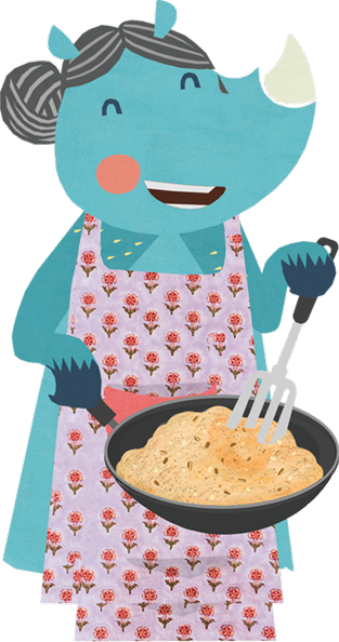Deciding on the right milk can be challenging for parents who want to make the healthiest choices for their little ones.
Traditionally, cow’s milk is offered to babies. But nowadays, many parents opt for non-dairy milk (or plant-based milk) for various reasons. The baby may have an allergy or intolerance to cow’s milk or the parents may have dietary preferences.
 We suggest
We suggest
The Deep Bond Between Babies & Milk
0-6 months: From birth to 6 months, babies rely exclusively on breast or formula milk for their nourishment. During this time, breast milk or formula remains the primary source of nutrition, complemented by the gradual introduction of solid foods.
12 months and above: Once your baby touches 1 year, you can begin incorporating some form of milk into their diet, and it's typically a good time to discontinue formula. Mothers are also advised to gradually reduce the amount of breast milk given to babies after their first birthday. Both WHO and UNICEF recommend breastfeeding babies up to 2 years of age.
What Type of Milk Can Babies Have?

1) Breast Milk: WHO recommends continuing breastfeeding until the age of 2 to fulfill the nutritional needs of toddlers.
- When is just breast milk enough? Approximately 4 breastfeeding sessions a day is sufficient for. If this is your routine, there’s no need to introduce other types of milk
- Why is breast milk fantastic? Breastfeeding supplies essential nutrition (like calcium), hydration, and immune support for babies.
- When to offer breast milk? Breast milk should not replace your baby’s solid food routine. Avoid breastfeeding before or after a meal; nurse them 40 minutes after their meal.
-
Why does breast milk go from being a main actor to a supporting actor? Post 1 year, the focus shifts from milk to solid food as the primary source of nutrition. Breast milk should now be treated as a snack and not given on demand when the baby asks for it.

- How to include more dairy? If your baby does not breastfeed four times a day, offer them dairy products to meet their calcium intake (e.g. if they have two breastfeeds per day, maybe add 1-2 servings of dairy products to their solid meals).
-
Should you seek professional help? If your baby cannot have dairy for various reasons, speak to a nutritionist to help you design a well-balanced meal plan so your baby does not miss out on essential nutrition.

2) Formula Milk: Breastfeeding may not be an option for every mother, especially if they've returned to work or gradually reduced the number of feeds after their baby turns one.
- Why is formula a familiar choice? Many babies are on formula from birth, so it’s their primary source of nutrition. This continues 6-12 months alongside solid food.
- Should you change the formula with age? Various types of formula milk are available for babies post 1 year, but these are not necessary. Some formulas may contain added sweeteners, which should be avoided.
-
Why is formula a less inconvenient option? If you choose to continue giving formula, use the same formula you've been using. But, formula can be more expensive compared to cow's milk or other milk.

- Should you make the switch to cow’s milk? Whenever possible, it's good to switch to cow's milk or an alternative milk when your baby turns 1. Now, your baby does not need formula, but it’s entirely up to you.

-
How to balance formula with solid meals? A baby’s consumption of formula should reduce when they turn 1 - not more than 400 ml a day. Like breast milk, make sure formula feed does not interfere with their solid foods..

3) Cow’s Milk: Traditionally, cow's milk has been a popular choice when it comes to weaning babies off of breast or formula milk.
- Why don’t we introduce cow’s milk as a beverage before babies are 1? As mentioned earlier, cow’s milk is tough for infants to digest; having too much of it can interfere with their body's ability to absorb iron effectively. For more details, here’s a recap: “Safe Ways to Introduce Dairy in Your Baby’s Diet”
- Why is cow’s milk a nutritional powerhouse? Full-fat cow's milk is a rich source of healthy fats, protein, zinc, vitamin A, and vitamin B12.
-
Why is cow’s milk a traditional favorite in India? Cow's milk is readily accessible, making it convenient for many. In India, there is a significant concern regarding vitamin A and D deficiencies among young children, so consuming cow's milk is a good way to prevent these deficiencies.

- Why full fat only? For at least the first 2 years of your baby's life, offer them only full-fat cow's milk (not avoid skimmed) so they get the healthy fats needed for growth and development!
-
When and how much to offer? Like cow’s milk, never offer buffalo, sheep, or goat milk to your baby as a beverage before 1 year. After they turn 1, offer them in small quantities.

- Can we offer raw milk? Never! Any animal-sourced milk you offer must be pasteurized. Raw or unpasteurized milk, straight from the cow, goat, buffalo, or sheep, can have harmful bacteria and germs and is a serious risk to babies.
Do 1-Year-Olds "Need" to Drink Milk?
Milk is not a compulsory part of your toddler's diet. But, it’s a convenient source of nutrition and a reliable source of calories, calcium, fat, and protein. Babies have small appetites. Milk is a familiar, nutritious beverage to bridge the gap between their early feeding habits and a more diversified diet.

If your little one does not like milk or if you choose not to give them: Ensure they get the nutrients through alternatives like dairy products (curd, paneer, cheese) and other solid food (green leafy vegetables, lentils, millets, sesame seeds, sprouts, nuts) that contain nutrients. Speak to your doctor for more advice.
How Much Milk Can Babies Have?

Now that your child is over 1 year, you can introduce any top-up milk (mentioned above) into their diet, but in moderate amounts. Limit your baby's milk consumption to less than 400 ml a day when offered as a standalone beverage.
In addition to milk, you can provide other dairy products like curd, cheese, paneer, and so on to diversify their calcium intake.
Choosing Non-Dairy Milk for Your Little One: Our 5 Top Tips
Many children may have a sensitivity to cow's milk for various reasons like difficulty in digestion/intolerance or a milk protein allergy. It could also be because the parents have made a conscious decision for health or ethical reasons.

Several plant-based milk alternatives are available in India like soy milk, oat milk, cashew milk, almond milk, and rice milk. While these other milks might come close, they are not equal in terms of nutrition. Cow’s milk is the best choice for babies at this age. Plant milk is not a substitute for cow’s milk at this age as they don’t have the nutrient profile that babies need to grow well at this age.
 Did you know
Did you know
Here are some things to consider when selecting plant-based milk options:
1) Till your baby is 1, they cannot drink any kind of dairy or plant-based milk as a beverage. You can mix small quantities of plant milk while preparing their food.
2) If babies are non-vegetarian, they get some essential nutrients from meat, so they are less dependent on milk for “nutrition” (compared to vegetarian babies whose nutritional needs are fulfilled by milk).
3) Fortified soy milk is one of the few alternative milk options that can help meet your baby's nutritional needs.
4) The nutritional content of plant-based milk will vary from brand to brand, so review the nutritional label carefully before you purchase.
5) Always opt for unflavored and unsweetened plant milk to avoid additional or hidden sugars.
6) None of these alternative milks should replace your baby's solid meals. After your baby turns 1, the primary focus of their diet should be balanced meals, with milk being the supplementary beverage.
Non-Dairy Milk Alternatives: Which Are Suitable for Your Baby?
Non-dairy milk alternatives should not be chosen for babies as a regular choice. Generally, a pediatrician or child nutritionist will advise this for babies in special cases.
|
Which plant milk is OK |
Which plant milk is NOT OK |
|
Fortified soy milk
|
Almond milk
|
|
Pea protein milk
|
Coconut milk
|
|
Oat milk
|
Other alternatives
|





















